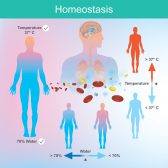physiological processes
The functions of living organisms and their parts, and the physical and chemical factors and processes involved.
You will also like...

Animal Water Regulation
Animals adapt to their environment in aspects of anatomy, physiology, and behavior. This tutorial will help you understand how animals adapt to their habitat. For instance, how animals thrive in aquatic habitat and are able to overcome osmosis. It also sheds light on the reasons animals adapt...

Consciousness and Behavior
Human consciousness and behavior are an interesting topic since they are determined and controlled by the brain. Consciousness can be defined by behavior or by electrical pattern of brain activity. Read this tutorial to learn about brain activities, such as sleep, attention, emotion, motivation, consciousness disorders, learning, and memory...

Growth and Plant Hormones
Plants, like animals, produce hormones to regulate plant activities, including growth. They need these hormones to respond well to their environment and to sustain growth, development, and dispersal. Plant biologists recognize five major groups of plant hormones: auxins, gibberellins, ethylene, cytokinins, and abscisic acid. Find out in this guide the importance of each hormone in the life of a plant...

Kidneys and Regulation of Water and Inorganic Ions
The kidneys are responsible for the regulation of water and inorganic ions. Read this tutorial to learn about the different parts of the kidneys and its role in homeostasis...

Physiological Homeostasis
Homeostasis is essential to maintain conditions within the tolerable limits. Otherwise, the body will fail to function properly. The body does this through feedback control mechanisms, e.g. blood sugar level regulation and temperature regulation. Read this tutorial to know more about the principles of negative feedback control employed by the body to sustain homeostasis...

Homeostatic Mechanisms and Cellular Communication
Homeostasis is the relatively stable conditions of the internal environment that result from compensatory regulatory responses performed by homeostatic control systems. Know the different components of homeostatic control systems, homeostatic regulators, and the various biological processes that homeostasis entail...
